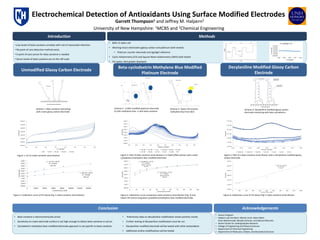Melden
Teilen

Empfohlen
Empfohlen
Outline of presentation:
Overview — Plating Baths and High Pressure Liquid Chromatography (HPLC)
Determination of Accelerator and Suppressor by HPLC and Charged Aerosol Detection
Sample Preparation, Calibration, Measurements
Comparisons to CVS data
Determination of Accelerator and Leveller by HPLC and Electrochemical Detection (ECD)
Coulometric Detection Mechanism and Design
Calibration and Measurements
Nickel Additives, Saccharin and Sodium Alkylsulfate
Gage Study Results
A Comparative Analysis of Semiconductor Electroplating Bath Additives by Cali...

A Comparative Analysis of Semiconductor Electroplating Bath Additives by Cali...Chromatography & Mass Spectrometry Solutions
Weitere ähnliche Inhalte
Andere mochten auch
Andere mochten auch (6)
Ähnlich wie 8311
Outline of presentation:
Overview — Plating Baths and High Pressure Liquid Chromatography (HPLC)
Determination of Accelerator and Suppressor by HPLC and Charged Aerosol Detection
Sample Preparation, Calibration, Measurements
Comparisons to CVS data
Determination of Accelerator and Leveller by HPLC and Electrochemical Detection (ECD)
Coulometric Detection Mechanism and Design
Calibration and Measurements
Nickel Additives, Saccharin and Sodium Alkylsulfate
Gage Study Results
A Comparative Analysis of Semiconductor Electroplating Bath Additives by Cali...

A Comparative Analysis of Semiconductor Electroplating Bath Additives by Cali...Chromatography & Mass Spectrometry Solutions
Ähnlich wie 8311 (8)
A Comparative Analysis of Semiconductor Electroplating Bath Additives by Cali...

A Comparative Analysis of Semiconductor Electroplating Bath Additives by Cali...
Electrochemical Degradation of Methylen Blue Using Carbon Composite Electrode...

Electrochemical Degradation of Methylen Blue Using Carbon Composite Electrode...
Spectrophotometric methods for determoination of Proteins 

Spectrophotometric methods for determoination of Proteins
8311
- 1. • BASi C3 static cell • Working macro electrodes (glassy carbon and platinum both tested) • Platinum counter electrode and Ag/AgCl reference • Cyclic Voltammetry (CV) and Square Wave Voltammetry (SWV) both tested • For space, best graphs displayed. • Low levels of beta-carotene correlate with risk of myocardial infarction • No point of care detection method exists • A point of care sensor for beta-carotene is needed • Serum levels of beta-carotene are on the nM scale Electrochemical Detection of Antioxidants Using Surface Modified Electrodes Garrett Thompson1 and Jeffrey M. Halpern2 University of New Hampshire: 1MCBS and 2Chemical Engineering Scheme 1: Beta-carotene interacting with a bare glassy carbon electrode Figure 1: CV of a beta-carotene serial dilution Figure 2: Calibration curve of the above (Fig 1.) beta-carotene serial dilution Scheme 2: a) BCD modified platinum electrode b) with methylene blue c) with beta-carotene Scheme 3: Tween 20 removes methylene blue from BCD Figure 3: SWV of beta-carotene serial dilution in a Tween/PBS solution with a beta- cyclodextrin/methylene blue modified electrode. Figure 4: Calibration curve comparing a beta-carotene serial dilution (Fig. 3) and tween 20 control using beta-cyclodextrin/methylene blue modified electrode. Scheme 4: Decylaniline modified glassy carbon electrode interacting with beta-cyclodextrin Figure 5: SWV of a beta-carotene serial dilution with a decylaniline modified glassy carbon electrode. Figure 6: Calibration curve of the above (Fig 5.) beta-carotene serial dilution Introduction Methods Unmodified Glassy Carbon Electrode Beta-cyclodextrin Methylene Blue Modified Platinum Electrode Decylaniline Modified Glassy Carbon Electrode Conclusion Acknowledgements • Beta-carotene is electrochemically active • Sensitivity at a bare electrode surface is not high enough to detect beta-carotene in serum • Cyclodextrin methylene blue modified electrode approach is not specific to beta-carotene • Preliminary data on decylaniline modification shows positive results • Further testing of decylaniline modification must be run • Decylaniline modified electrode will be tested with other antioxidants • Additional aniline modifications will be tested • Honors Program • Halpern Lab members: Mariah Arral, Alexis Mack, Elnaz Mohammadi, Micaela Schones, and Sabrina Marnoto • Hamel Center for Undergraduate Research • College of Engineering and Physical Sciences • Department of Chemical Engineering • Department of Molecular, Cellular, and Biomedical Sciences